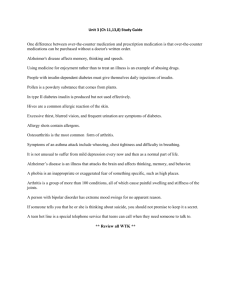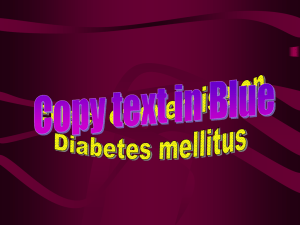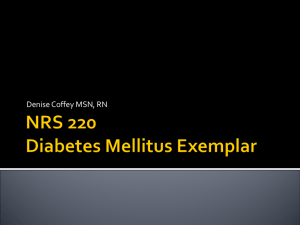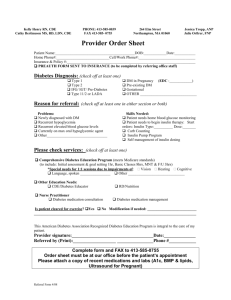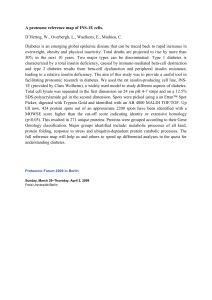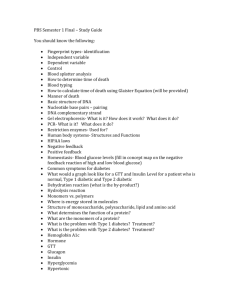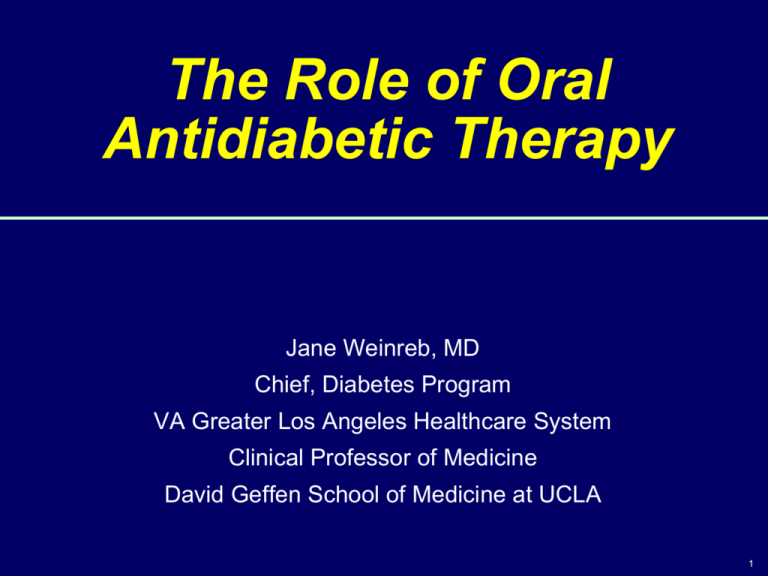
The Role of Oral
Antidiabetic Therapy
Jane Weinreb, MD
Chief, Diabetes Program
VA Greater Los Angeles Healthcare System
Clinical Professor of Medicine
David Geffen School of Medicine at UCLA
1
Objectives
• To review major pathophysiologic defects in Type 2
Diabetes and targeted sites for medications
• To review available classes as well as specific oral
antidiabetic medications: mechanism of action,
efficacy, adverse effects
• Discuss role of combination therapy
• Discuss AACE Diabetes Roadmap and case
presentation
2
Overview of Glucose Regulation
Glucose
Alpha glucosidase
inhibitors
Defective insulin
secretion
Sulfonylureas
Meglitinides
b-cell insulin
secretion Persistent
Hepatic Glucose
Output
DPP-IV Inhibitors
Thiazolidinediones
Metformin
Insulin action
Amended from Dinneen SF. Diabetes Med. 1997;14(suppl 3):S19-24.
Resistance to
insulin action
3
Overview of Available Agents
• Biguanides
– Metformin
• Secretagogues
– Sulfonylureas: Glipizide, Glyburide, Glimepiride
– Glinides: Nateglinide, Repaglinide
• Thiazolidinediones
– Pioglitazone, Rosiglitazone
• Alpha Glucosidase Inhibitors
– Acarbose, Miglitol
• Dipeptidyl-Peptidase 4 Inhibitors
– Sitagliptin
• Bile Acid Sequestrant
– Colesevalam
AACE Diabetes Melllitus Guidelines, Endocr Pract. 2007; 13 (suppl 1) 2007
4
Biguanide
• Agent in Class: Metformin
• Mechanism of action: poorly understood, but its primary
effect is to reduce hepatic glucose production in the presence
of insulin
• Efficacy: lowers A1C by 1 to 2%, maximum effective dose is 2
grams/d
• Major advantages:
– Lack of weight gain or modest weight loss
– Absence of or infrequent hypoglycemia
AACE Diabetes Mellitus Guidelines, Endocr Pract. 2007; 13 (suppl 1) 2007
Medical Management of Hyperglycemia in Type 2 Diabetes: A Consensus Algorithm for the Initiation and
Adjustment of Therapy: Diabetes Care, Vol 31(12):1-11 2008
5
Biguanide
• Adverse effects mainly GI: abdominal pain, bloating, nausea, and
diarrhea (minimize by slow titration)
• Contraindication: renal dysfunction, Cr >1.5 mg/dL in men and Cr
> 1.4 mg/dL in women
• Avoid in patients with hepatic dysfunction, CHF, metabolic
acidosis, dehydration, and alcoholism
• Available combinations with sulfonylureas, thiazolidinediones,
repaglinide, and sitagliptin
AACE Diabetes Mellitus Guidelines, Endocr Pract. 2007; 13 (suppl 1) 2007
Medical Management of Hyperglycemia in Type 2 Diabetes: A Consensus Algorithm for the
Initiation and Adjustment of Therapy: Diabetes Care, 31(12):10-11, 2008
6
Secretagogues: Sulfonylureas
• Agents in Class: Glipizide, Glyburide, and Glimepiride
• Mechanism of action: increase insulin secretion from pancreatic
beta cells
• Efficacy: lower A1C by 1-2%; glucose-lowering effect usually
plateaus at one half of the maximum recommended dose
• Nonglycemic effects: weight gain is common
• Major Advantages:
– Long track record of safety
– Low price of generic preps
AACE Diabetes Mellitus Guidelines, Endocr Pract. 2007; 13 (suppl 1) 2007
Medical Management of Hyperglycemia in Type 2 Diabetes: A Consensus Algorithm for the
Initiation and Adjustment of Therapy: Diabetes Care, 31(12):10-11, 2008
7
Secretagogues: Sulfonylureas
• Adverse effect: mainly hypoglycemia, which can be prolonged and
more frequent in elderly or with impaired renal function (glipizide and
glimepiride may be preferred in elderly patient)
• Avoid in hepatic and renal impairment
• Available combinations with metformin, both thiazolidinediones, and
acarbose
AACE Diabetes Mellitus Guidelines, Endocr Pract. 2007; 13 (suppl 1) 2007
Medical Management of Hyperglycemia in Type 2 Diabetes: A Consensus Algorithm for the
Initiation and Adjustment of Therapy: Diabetes Care, 31(12):10-11, 2008
8
Secretagogues: Glinides
• Agents in Class: Nateglinide, Repaglinide
• Mechanism of action: stimulate a rapid but short-lived
release of insulin that lasts for 1-2 hours, therefore should
be used to target postprandial glucose levels
• Efficacy: similar to SU’s for repaglinide; nateglinide is less
efficacious in A1C lowering (0.5-0.8%)
• Nonglycemic effect: weight gain similar to SU
AACE Diabetes Mellitus Guidelines, Endocr Pract. 2007; 13 (suppl 1) 2007
Medical Management of Hyperglycemia in Type 2 Diabetes: A Consensus Algorithm for the
Initiation and Adjustment of Therapy: Diabetes Care, 31(12):10-11, 2008
9
Secretagogues: Glinides
• Adverse effect:
– Much less hypoglycemia than SU
– Many drug-drug interactions. Most concerning is gemfibrozil
which increases repaglinide concentration and may result in
prolonged lows.
• Used with caution in patients with hepatic impairment
• Nateglinide is renally cleared, whereas this is minimal for
repaglinide latter can be used with renal impairment
• Available combination: repaglinide with metformin
AACE Diabetes Mellitus Guidelines, Endocr Pract. 2007; 13 (suppl 1) 2007
Medical Management of Hyperglycemia in Type 2 Diabetes: A Consensus Algorithm for the
Initiation and Adjustment of Therapy: Diabetes Care, 31(12):10-11, 2008
10
Thiazolidinediones
• Agents in class: Pioglitazone, Rosiglitazone
• Mechanism of action: Enhancing peripheral insulin sensitivity,
especially at the muscle and adipose tissue, via activation of
PPAR (peroxisome proliferator-activated receptor gamma).
• Efficacy: lower A1C 0.8 to 1.5% (decrease in glucose may not
be apparent for 4 weeks and maximum efficacy of dose may
not be observed for 4-6 months)
• Nonglycemic effects:
– weight gain
– enhances fibrinolysis
- modestly reduce blood pressure
- improve endothelial dysfunction
AACE Diabetes Mellitus Guidelines, Endocr Pract. 2007; 13 (suppl 1) 2007
Medical Management of Hyperglycemia in Type 2 Diabetes: A Consensus Algorithm for the
Initiation and Adjustment of Therapy: Diabetes Care, 31(12):10-11, 2008
11
Thiazolidinediones
• Major advantages:
– absence of hypoglycemia when used as monotherapy
– no reliance on renal excretion.
• Adverse effects: weight gain, edema, anemia, and peripheral fractures
in women
• Contraindications: should not be used in patients with CHF (New York
Heart Association class III or IV cardiac disease and functional
capacity) or hepatic impairment with ALT > 2.5 times the upper normal
limits
• Available combinations with metformin and sulfonylurea
AACE Diabetes Mellitus Guidelines, Endocr Pract. 2007; 13 (suppl 1) 2007
Medical Management of Hyperglycemia in Type 2 Diabetes: A Consensus Algorithm for the
Initiation and Adjustment of Therapy: Diabetes Care, 31(12):10-11, 2008
12
Alpha-Glucosidase Inhibitors
• Agents in Class: Acarbose, Miglitol
• Mechanisms of action: decrease the rate of digestion for
polysaccharides in the proximal small intestine, primarily lowering
postprandial glucose levels
• Efficacy: lower A1C by 0.5 to 1.0%
• Adverse effects: flatulence, diarrhea, and abdominal discomfort
(minimize by slow titration).
• Available combination with sulfonylurea
AACE Diabetes Mellitus Guidelines, Endocr Pract. 2007; 13 (suppl 1) 2007
Medical Management of Hyperglycemia in Type 2 Diabetes: A Consensus Algorithm for the
Initiation and Adjustment of Therapy: Diabetes Care, 31(12):10-11, 2008
13
Dipeptidyl-Peptidase 4 Inhibitors
• Agent in Class: Sitagliptin, Saxagliptin
• Mechanism of action:
– slows the inactivation of incretin hormones (glucagonlike peptide 1 and glucose-dependent insulinotropic
polypeptide)
Increases glucose-stimulated insulin secretion
Causes glucose-stimulated glucagon suppression
– primarily lowers postprandial glucose levels but has
also been shown to reduce fasting plasma glucose
AACE Diabetes Mellitus Guidelines, Endocr Pract. 2007; 13 (suppl 1) 2007
Medical Management of Hyperglycemia in Type 2 Diabetes: A Consensus Algorithm for the Initiation
and Adjustment of Therapy: Diabetes Care, Vol 31(12):1-11, 2008
14
Inhibition of DPP-IV Increases Active Portal
GLP-1 and GIP
• DPP-IV inhibitors exhibit
both short term and long
term actions of GLP-1
T ½=1-2mins
– Augment glucose induced
insulin secretion
– Inhibit glucagon secretion
– Slow gastric emptying
– Increase insulin biosynthesis
– Promote beta cell
differentiation
15
Dipeptidyl-Peptidase 4 Inhibitors
• Efficacy: Lower HbA1C by 0.8%
• Nonglycemic effect: weight neutral
• Adverse effects: well tolerated, no hypoglycemia when used as
monotherapy. More recently reported to be associated with
pancreatitis, ?causative?
• Available combination with metformin
AACE Diabetes Mellitus Guidelines, Endocr Pract. 2007; 13 (suppl 1) 2007
Medical Management of Hyperglycemia in Type 2 Diabetes: A Consensus Algorithm for the Initiation
and Adjustment of Therapy: Diabetes Care, Vol 31(12):1-11, 2008
16
Bile Acid Sequestrant
Agent in Class: Colesevalam
Mechanism of action uncertain
Efficacy: Lowers the A1C 0.5-8% when added
to metformin, sulfonylurea or insulin
Not studied as monotherapy or in combination with
incretins or TZD’s
Significant LDL-C reductions of 12.3-16.1% vs.
placebo
Bays HE, et al. Arch Intern Med. In press.
Fonseca VA, et al. Diabetes Care. 2008; 31: 1479-1484.
Goldberg RB, et al. Arch Intern Med. 2008; 168: 1531-1540.
Colesevelam
Take with meals and liquid either 6 tablets once
daily or 3 tablets twice daily
No special considerations or dosage adjustments
with hepatic impairment or renal disease
Contraindications:
History of bowel obstruction
Serum triglycerides >500 mg/dL
History of hypertriglyceridemia-induced pancreatitis
Welchol® (colesevelam HCl) prescribing information. Daiichi Sankyo, Inc., Parsippany, NJ. January 2008.
Colesevelam: Drug Interactions
Drugs with a known interaction with
colesevelam- administer 4 hours prior
to colesevalam
Glyburide, levothyroxine, and oral
contraceptives containing ethinyl
estradiol and norethindrone
Drugs with postmarketing reports
consistent with potential drug-drug
interactions when coadministered
with colesevelam
Phenytoin- Should be administered 4
hrs before colesevalam
Warfarin- No noted problem with
colesevalam coadministration, but
study did not eval INR
Drugs that do not interact with
colesevelam based on in vitro or in
vivo testing
Cephalexin, ciprofloxacin, digoxin,
warfarin, fenofibrate, lovastatin,
metformin, metoprolol, pioglitazone,
quinidine, repaglinide, valproic acid,
verapamil
Colesevelam in Type 2 DM:
Adverse Reactions*
Event Description
Number of Patients (%)
Colesevalam
N = 566
Placebo
N = 562
Constipation
49 (8.7)
11 (2.0)
Nasopharyngitis
23 (4.1)
20 (3.6)
Dyspepsia
22 (3.9)
8 (1.4)
Hypoglycemia
17 (3.0)
13 (2.3)
Nausea
17 (3.0)
8 (1.4)
Hypertension
16 (2.8)
9 (1.6)
*Placebo-Controlled Clinical Studies of Colesevelam Add-on Combination Therapy with Metformin, Insulin,
Sulfonylureas: Adverse Reactions Reported in ≥2% of Patients and More Commonly than in Patients Given
Placebo, Regardless of Investigator Assessment of Causality. Colesevelam HCl prescribing information,
January 2008.
Considerations in the
Management of Type 2
Diabetes
Monotherapy vs. Combination
Therapy
21
Traditional Monotherapies Do Not Maintain
A1C Control Over Time
United Kingdom Prospective Diabetes Study (UKPDS)
10
Median A1C (%)
9
8
7
6
0
ADA Goal
0
3
6
9
12
Conventional*
Insulin
Glibenclamide (glyburide)
Metformin
15
Time From Randomization (Years)
*Conventional therapy defined as dietary advice given at 3-month intervals where FPG was targeted at best levels feasible in clinical
practice. If FPG exceeded 270 mg/dL, then patients were re-randomized to receive non-intensive metformin, chlorpropamide,
glibenclamide, or insulin. If FPG exceeded 270 mg/dL again, then those on SU would have metformin added. If FPG exceeded
270 mg/dL after this, then insulin was substituted.
Adapted with permission from UK Prospective Diabetes Study (UKPDS 34) Group. Lancet. 1998;352:854-865.
22
Two Year Efficacy of Pioglitazone:
Time Course of A1C
Pioglitazone
23
ADOPT: A Diabetes Outcome Progression Trial
Rosiglitazone Sustained A1C Over Time*
8.0
Treatment Difference at 4 Years
RSG vs MET –0.13 (–0.22 to –0.05), P=.002
RSG vs GLYB –0.42 (–0.50 to –0.33), P<.001
GLYB
HbA1C (%)
7.5
MET
RSG
7.0
6.5
6.0
0
0
1
2
3
4
5
2197
822
Time (years)
Number of patients: 4012
3308
2991
2583
* Mean A1C values per visit are based on a repeated measures mixed model.
Kahn SE et al. N Engl J Med. 2006;355:2427-2443.
24
Why Combination Therapy Make
Sense
Treat to Fail vs. Treat to succeed
25
Major Targeted Sites of Oral Drug Classes
Pancreas
Beta-cell
dysfunction
Sulfonylureas
Liver
Muscle
and fat
Glinides
DPP-4 inhibitors
Hepatic glucose
overproduction
Biguanides
↓Glucose level
Insulin
resistance
Gut
TZDs
TZDs
Biguanides
DPP-4 inhibitors
Glucose
absorption
Alphaglucosidase
inhibitors
Biguanides
DPP-4=dipeptidyl peptidase-4; TZDs=thiazolidinediones.
DeFronzo RA. Ann Intern Med. 1999;131:281–303.
Buse JB et al. In: Williams Textbook of Endocrinology. 10th ed. Philadelphia: WB Saunders; 2003:1427–1483.
26
Rosiglitazone/Metformin Combination: Additive
Glycemic Control vs Metformin Alone
Placebo + Met
RSG 4 mg QD + Met
RSG 8 mg QD + Met
Mean Change in HbA1c (%)
1.0
0.5
0.0
-0.5
-1.0
-1.5
-1.0*
-1.2*
-2.0
Compared to
Baseline
Treatment Effect
*P<0.0001 vs. metformin
27
Change From Baseline (% points)
Pioglitazone Added to Metformin
HbA1c
1
*
0.5
*
*
0
-0.5
*
-1
*
-1.5
- 0.8% points
* * P0.05 vs
Metformin +
placebo
-2
-2.5
-6
0
8
Weeks
Met + Placebo
* P0.05 vs baseline
12
16
LOCF
Met + pio 30 mg
.
28
Sitagliptin A1C Reductions From Baseline When
Added to Metformin or Pioglitazone
0
–0.2
Add-on to metformin study1
Add-on to pioglitazone study2
Mean Baseline A1C: 8.0%
Mean Baseline A1C: 8.0%, 8.1%
Pioglitazone Pioglitazone
+ Placebo + sitagliptin
Metformin
+ Placebo
Metformin
sitagliptin
n=224
n=453
–0.0%
–0.4
–0.6
P<0.001*
–0.8
–0.7%
–1.0
0.7% placebosubtracted result
*Compared with placebo.
1. Charbonnel B et al. Diabetes Care. 2006;29:2638–2643.
2. Rosenstock J et al. Clin Ther. 2006;28:1556–1568.
Mean Change in A1C From Baseline, %
Mean Change in A1C From Baseline, %
24-week change from baseline
0
n=174
n=163
–0.2
–0.2%
–0.4
–0.6
–0.8
–1.0
P<0.001*
–0.9%
0.7% placebosubtracted result
29
RSG/Met Reductions in A1C in Drug-Naïve Patients
D -0.4 P<.001*
D -0.6 P<.0001*
Mean change from baseline
in A1C (%) at Week 32
0
-0.5
-1
–1.6%
-1.5
-2
-2.5
Baseline A1C (%)
n=
Mean final dose
–1.8%
–2.3%
RSG/Met
8.9
152
7.2 mg/1799 mg
RSG
8.8
155
7.7 mg
MET
8.8
150
1847 mg
.
Rosenstock J et al. Diabetes Obes Metab. 2006;8:650–660.
30
AACE Diabetes Roadmap
• Guide to therapy base on A1C level
• Initiation as well as maintaining therapy
AACE Diabetes Mellitus Guidelines, Endocr Pract. 2007; 13 (suppl 1) 2007
31
Road Map to Achieve Glycemic Goals: Naïve to Therapy (Type 2)
Achieve ACE
Glycemic Goals†
( FPG, PPG, and A1C )
Initial
A1C%
If ≤ 6.5% A1C Goal
Not Achieved
Initial Therapy
Lifestyle
Modification
6-7
Intervention
Continuous
Titration of Rx
( 2 - 3 months )
Assess FPG
and PPG
Preferred:
• Metformin4
• TZD10,11,12
• AGI
• DPP-4 Inhibitor
Alternatives
• Glinides
• SU (low dose)
• Prandial insulin5,8
Monitor / adjust Rx
to maximal effective
dose to meet ACE
Glycemic Goals
Intensify Lifestyle
Modification
Intensify or combine Rx
including incretin mimetic*1
If ≤ 6.5% A1C Goal
Not Achieved
Lifestyle
Modification
7-8
Combine Therapies
Target: PPG
and FPG
•
•
•
•
•
•
•
Metformin
Glinides
AGI
TZD12
SU
DPP-4 Inhibitor + met
Colesevelam + met,
SU or insulin
6,7
Alternatives
• Prandial insulin5,8
• Premixed insulin
preparations5
• Basal insulin
analog9
* Available as exenatide
†ACE Glycemic Goals
1 Indicated for patients not at goal despite SU and/or metformin or
TZD therapy; incretin mimetic is not indicated for insulin-using patients
≤ 6.5% A1C
4 Preferred first agent in most patients
< 110 mg/dL FPG
5 Analog preparations preferred
< 110 mg/dL Preprandial
6 Appropriate for most patients
< 140 mg/dL 2-hr PPG
7 2 or more agents may be required
8 Rapid-acting insulin analog (available as lispro, aspart and glulisine)
or regular insulin
9 Available as glargine and detemir
10 A recent meta-analysis suggests a possible link of rosiglitazone to
cardiovascular events; other studies do not confirm or exclude this risk. The
FDA has stated “In their entirety, the available data on the risk of myocardial
infarction are inconclusive.”
11 Cannot be used in NYHA CHF Class 3 or 4
12 According to the FDA, rosiglitazone not recommended with insulin
Endocr Pract. 2007;13:260-268
Monitor / adjust Rx
to maximal effective
dose to meet ACE
Glycemic Goals
Intensify Lifestyle
Modification
Intensify or combine Rx,
including incretin mimetic
with SU, TZD, and/or
metformin
ACE/AACE Diabetes Road Map Task Force
Paul S. Jellinger, MD, MACE, Co-Chair
Jaime A. Davidson, MD, FACE, Co-Chair
Lawrence Blonde, MD, FACP, FACE
Daniel Einhorn, MD, FACP, FACE
George Grunberger, MD, FACP, FACE
Yehuda Handelsman, MD, FACP, FACE
Richard Hellman, MD, FACP, FACE
Harold Lebovitz, MD, FACE
Philip Levy, MD, FACE
Victor L. Roberts, MD, MBA, FACP, FACE
Revision April 2008
© 2008 AACE. All rights reserved. No portion of the Roadmap may be altered,
reproduced or distributed in any form without the express permission of AACE.
32
Road Map to Achieve Glycemic Goals: Naïve to Therapy (Type 2)
Achieve ACE
Glycemic Goals†
( FPG, PPG, and A1C )
Initial
A1C%
Intervention
Combine Therapies
to Address FPG and PPG7
Lifestyle
Modification
8-9
Continuous
Titration of Rx
( 2 - 3 months )
Target: FPG
and PPG
• Metformin
• TZD10,11,12
• SU
• Glinides
• DPP-4 Inhibitor
• Basal insulin analog9
• Prandial
• Premixed insulin
preparations5
• NPH
• Other approved
combinations
insulin5,8
Monitor / adjust Rx
to maximal effective
dose to meet ACE
Glycemic Goals
If ≤ 6.5% A1C Goal
Not Achieved
Intensify Lifestyle Modification
Intensify or combine Rx including
prandial insulin5,8, incretin
mimetic1, or amylin analog**
(with prandial insulin5,8)
If ≤ 6.5% A1C Goal
Not Achieved
Lifestyle
Modification
9 - 10
Target: FPG
and PPG
Combine Therapies
to Address FPG and PPG7
• Prandial insulin5,8
• Metformin
• TZD12
• Premixed insulin
preparations5
• SU
• NPH
• Glinides
• Basal insulin analog9 • Other approved
combinations
Monitor / adjust Rx
to maximal effective
dose to meet ACE
Glycemic Goals
Intensify Lifestyle Modification
Initiate or intensify insulin
therapy or add incretin mimetic1
** Available as pramlintide
1 Indicated for patients not at goal despite SU and/or metformin or
TZD therapy; incretin mimetic is not indicated for insulin-using patients
5 Analog preparations preferred
7 2 or more agents may be required
8 Rapid-acting insulin analog (available as lispro, aspart and glulisine)
or regular insulin
9 Available as glargine and detemir
10 A recent meta-analysis suggests a possible link of rosiglitazone to
cardiovascular events; other studies do not confirm or exclude this risk. The
FDA has stated “In their entirety, the available data on the risk of myocardial
infarction are inconclusive.”
11 Cannot be used in NYHA CHF Class 3 or 4
12 According to the FDA, rosiglitazone not recommended with insulin
Endocr Pract. 2007;13:260-268
†ACE
Glycemic Goals
≤ 6.5% A1C
< 110 mg/dL FPG
< 110 mg/dL Preprandial
< 140 mg/dL 2-hr PPG
ACE/AACE Diabetes Road Map Task Force
Paul S. Jellinger, MD, MACE, Co-Chair
Jaime A. Davidson, MD, FACE, Co-Chair
Lawrence Blonde, MD, FACP, FACE
Daniel Einhorn, MD, FACP, FACE
George Grunberger, MD, FACP, FACE
Yehuda Handelsman, MD, FACP, FACE
Richard Hellman, MD, FACP, FACE
Harold Lebovitz, MD, FACE
Philip Levy, MD, FACE
Victor L. Roberts, MD, MBA, FACP, FACE
Revision April 2008
© 2008 AACE. All rights reserved. No portion of the Roadmap may be altered,
reproduced or distributed in any form without the express permission of AACE.
33
Road Map to Achieve Glycemic Goals: Naïve to Therapy (Type 2)
Initial
A1C%
3
5
8
9
Intervention
Insulin
Therapy2,3
• Basal insulin analog9
or NPH + prandial insulin5,8
• Premixed insulin preparations5
Lifestyle
2
Modification
> 10
Achieve ACE
Glycemic Goals†
( FPG, PPG, and A1C )
For selected patients presenting with an A1C of >10%,
certain oral agent combinations may be effective
Insulin sensitizer (metformin preferred) may be combined
with initial insulin therapy
Analog preparations preferred
Rapid-acting insulin analog (available as lispro, aspart and
glulisine) or regular insulin
Available as glargine and detemir
Endocr Pract. 2007;13:260-268
†ACE
Glycemic Goals
≤ 6.5% A1C
< 110 mg/dL FPG
< 110 mg/dL Preprandial
< 140 mg/dL 2-hr PPG
Continuous
Titration of Rx
( 2 - 3 months )
Monitor / adjust Rx
to maximal effective
dose to meet ACE
Glycemic Goals
If ≤ 6.5% A1C Goal Not
Achieved
Intensify Lifestyle
Modification
ACE/AACE Diabetes Road Map Task Force
Paul S. Jellinger, MD, MACE, Co-Chair
Jaime A. Davidson, MD, FACE, Co-Chair
Lawrence Blonde, MD, FACP, FACE
Daniel Einhorn, MD, FACP, FACE
George Grunberger, MD, FACP, FACE
Yehuda Handelsman, MD, FACP, FACE
Richard Hellman, MD, FACP, FACE
Harold Lebovitz, MD, FACE
Philip Levy, MD, FACE
Victor L. Roberts, MD, MBA, FACP, FACE
Revision April 2008
© 2008 AACE. All rights reserved. No portion of the Roadmap may be altered,
reproduced or distributed in any form without the express permission of AACE.
34
Road Map to Achieve Glycemic Goals: Treated Patients (Type 2)
Current
A1C%
to
8.5
*
Continue Lifestyle Modification
6.5
Current Therapy
Monotherapy :
Glinides, SU, AGI, metformin,
TZD, DPP-4, premixed insulin
preparations1, prandial2 or
basal insulin3
Combination Therapy:
Glinides, SU, DPP-4, AGI,
metformin, TZD, colesevelam,
incretin mimetic*, premixed
insulin preparations1,
prandial2 or basal insulin3
Intensify Lifestyle Modification
Initiate Combination Therapy
• Incretin mimetic +
Metformin + SU or Glinide
metformin and/or TZD
Metformin + TZD4,5 or AGI
TZD + SU
• Basal3 or premixed
insulin preparations1
DPP-4 + Metformin ± SU
DPP-4 + TZD
• Amylin analog** with
Colesevelam + met, SU or insulin
prandial insulin2
Incretin mimetic* + metformin
and/or SU
Other approved combinations including
approved oral agents with insulin6
•
•
•
•
•
•
•
Monitor / adjust Rx
to maintain ACE
Glycemic Goals†
Intensify Lifestyle Modification
Maximize Combination Therapy
Maximize Insulin Therapy
• If elevated FPG, add or increase basal insulin3
• If elevated PPG, add or increase prandial insulin2
• If elevated FPG and PPG, add or intensify basal3 +
prandial2 or premixed insulin therapy1
• Combine with approved oral agents6
• Amylin analog** with prandial insulin2
Add incretin mimetic to patients on SU, TZD,
and/or metformin
Monitor / adjust Rx
to maintain ACE
Glycemic Goals†
Available as exenatide
Available as pramlintide
1
Analog preparations preferred
2
Prandial insulin (rapid-acting insulin analogs available as lispro,
aspart, glulisine, or regular insulin) can be added
to any therapeutic intervention at any time to address persistent
postprandial hyperglycemia
5
6
Intervention
Continuous Titration of
Rx (2-3 months)
**
3
4
Continuous Titration of
Rx (2-3 months)
Available as glargine and detemir
A recent meta-analysis suggests a possible link of rosiglitazone to
cardiovascular events; other studies do not confirm or exclude this risk. The
FDA has stated “In their entirety, the available data on the risk of myocardial
infarction are inconclusive.”
Cannot be used in NYHA CHF Class 3 or 4
According to the FDA, rosiglitazone not recommended with insulin
Endocr Pract. 2007;13:260-268
†ACE
Glycemic Goals
≤ 6.5% A1C
< 110 mg/dL FPG
< 110 mg/dL Preprandial
< 140 mg/dL 2-hr PPG
ACE/AACE Diabetes Road Map Task Force
Paul S. Jellinger, MD, MACE, Co-Chair
Jaime A. Davidson, MD, FACE, Co-Chair
Lawrence Blonde, MD, FACP, FACE
Daniel Einhorn, MD, FACP, FACE
George Grunberger, MD, FACP, FACE
Yehuda Handelsman, MD, FACP, FACE
Richard Hellman, MD, FACP, FACE
Harold Lebovitz, MD, FACE
Philip Levy, MD, FACE
Victor L. Roberts, MD, MBA, FACP, FACE
Revision April 2008
© 2008 AACE. All rights reserved. No portion of the Roadmap may be altered,
reproduced or distributed in any form without the express permission of AACE.
35
Road Map to Achieve Glycemic Goals: Treated Patients (Type 2)
Current
A1C%
1
2
3
4
Continue Lifestyle
Modification
>8.5
Current Therapy
Intervention
Monotherapy
Intensify Lifestyle Modification
Initiate Insulin Therapy (Basal-Bolus)
or
Combination Therapy
Analog preparations preferred
Prandial insulin (rapid-acting insulin analogs available as lispro,
aspart, glulisine, or regular insulin) can be added to any
therapeutic intervention at any time to address persistent
postprandial hyperglycemia
Available as glargine and detemir
According to the FDA, rosiglitazone not recommended with insulin
Endocr Pract. 2007;13:260-268
• Basal3 + prandial insulin2
• Premixed insulin preparations1
Combine with approved oral agents4
†ACE
Glycemic Goals
≤ 6.5% A1C
< 110 mg/dL FPG
< 110 mg/dL Preprandial
< 140 mg/dL 2-hr PPG
Continuous Titration of
Rx (2-3 months)
Monitor / adjust Rx to
maintain ACE
Glycemic Goals†
ACE/AACE Diabetes Road Map Task Force
Paul S. Jellinger, MD, MACE, Co-Chair
Jaime A. Davidson, MD, FACE, Co-Chair
Lawrence Blonde, MD, FACP, FACE
Daniel Einhorn, MD, FACP, FACE
George Grunberger, MD, FACP, FACE
Yehuda Handelsman, MD, FACP, FACE
Richard Hellman, MD, FACP, FACE
Harold Lebovitz, MD, FACE
Philip Levy, MD, FACE
Victor L. Roberts, MD, MBA, FACP, FACE
Revision April 2008
© 2008 AACE. All rights reserved. No portion of the Roadmap may be altered,
reproduced or distributed in any form without the express permission of AACE.
36
Case Study: Mona
• Female, 60 years old, obese
• Serum creatinine: 1.4 mg/dL
• A1C: 6.9%
• Treatment-naive for diabetes
• Antihypertensive therapy
• History of inflammatory bowel disease
• Recent myocardial infarction
Treatment option(s):
?
37
Road Map to Achieve Glycemic Goals: Naïve to Therapy (Type 2)
Achieve ACE
Glycemic Goals†
( FPG, PPG, and A1C )
Initial
A1C%
If ≤ 6.5% A1C Goal
Not Achieved
Initial Therapy
Lifestyle
Modification
6-7
Intervention
Continuous
Titration of Rx
( 2 - 3 months )
Assess FPG
and PPG
Preferred:
• Metformin4
• TZD10,11,12
• AGI
• DPP-4 Inhibitor
Alternatives
• Glinides
• SU (low dose)
• Prandial insulin5,8
Monitor / adjust Rx
to maximal effective
dose to meet ACE
Glycemic Goals
Intensify Lifestyle
Modification
Intensify or combine Rx
including incretin mimetic*1
If ≤ 6.5% A1C Goal
Not Achieved
Lifestyle
Modification
7-8
Combine Therapies
Target: PPG
and FPG
•
•
•
•
•
•
•
Metformin
Glinides
AGI
TZD12
SU
DPP-4 Inhibitor + met
Colesevelam + met,
SU or insulin
6,7
Alternatives
• Prandial insulin5,8
• Premixed insulin
preparations5
• Basal insulin
analog9
* Available as exenatide
†ACE Glycemic Goals
1 Indicated for patients not at goal despite SU and/or metformin or
TZD therapy; incretin mimetic is not indicated for insulin-using patients
≤ 6.5% A1C
4 Preferred first agent in most patients
< 110 mg/dL FPG
5 Analog preparations preferred
< 110 mg/dL Preprandial
6 Appropriate for most patients
< 140 mg/dL 2-hr PPG
7 2 or more agents may be required
8 Rapid-acting insulin analog (available as lispro, aspart and glulisine)
or regular insulin
9 Available as glargine and detemir
10 A recent meta-analysis suggests a possible link of rosiglitazone to
cardiovascular events; other studies do not confirm or exclude this risk. The
FDA has stated “In their entirety, the available data on the risk of myocardial
infarction are inconclusive.”
11 Cannot be used in NYHA CHF Class 3 or 4
12 According to the FDA, rosiglitazone not recommended with insulin
Endocr Pract. 2007;13:260-268
Monitor / adjust Rx
to maximal effective
dose to meet ACE
Glycemic Goals
Intensify Lifestyle
Modification
Intensify or combine Rx,
including incretin mimetic
with SU, TZD, and/or
metformin
ACE/AACE Diabetes Road Map Task Force
Paul S. Jellinger, MD, MACE, Co-Chair
Jaime A. Davidson, MD, FACE, Co-Chair
Lawrence Blonde, MD, FACP, FACE
Daniel Einhorn, MD, FACP, FACE
George Grunberger, MD, FACP, FACE
Yehuda Handelsman, MD, FACP, FACE
Richard Hellman, MD, FACP, FACE
Harold Lebovitz, MD, FACE
Philip Levy, MD, FACE
Victor L. Roberts, MD, MBA, FACP, FACE
Revision April 2008
© 2008 AACE. All rights reserved. No portion of the Roadmap may be altered,
reproduced or distributed in any form without the express permission of AACE.
38
Case Study: Nancy
• Female, 55 years old, obese
• Serum creatinine: 1.0 mg/dL
• A1C: 8.5%
• Treatment-naive for diabetes
• Antihypertensive therapy
Treatment option(s):
?
39
Road Map to Achieve Glycemic Goals: Naïve to Therapy (Type 2)
Achieve ACE
Glycemic Goals†
( FPG, PPG, and A1C )
Initial
A1C%
Intervention
Combine Therapies
to Address FPG and PPG7
Lifestyle
Modification
8-9
Continuous
Titration of Rx
( 2 - 3 months )
Target: FPG
and PPG
• Metformin
• TZD10,11,12
• SU
• Glinides
• DPP-4 Inhibitor
• Basal insulin analog9
• Prandial
• Premixed insulin
preparations5
• NPH
• Other approved
combinations
insulin5,8
Monitor / adjust Rx
to maximal effective
dose to meet ACE
Glycemic Goals
If ≤ 6.5% A1C Goal
Not Achieved
Intensify Lifestyle Modification
Intensify or combine Rx including
prandial insulin5,8, incretin
mimetic1, or amylin analog**
(with prandial insulin5,8)
If ≤ 6.5% A1C Goal
Not Achieved
Lifestyle
Modification
9 - 10
Target: FPG
and PPG
Combine Therapies
to Address FPG and PPG7
• Prandial insulin5,8
• Metformin
• TZD12
• Premixed insulin
preparations5
• SU
• NPH
• Glinides
• Basal insulin analog9 • Other approved
combinations
Monitor / adjust Rx
to maximal effective
dose to meet ACE
Glycemic Goals
Intensify Lifestyle Modification
Initiate or intensify insulin
therapy or add incretin mimetic1
** Available as pramlintide
1 Indicated for patients not at goal despite SU and/or metformin or
TZD therapy; incretin mimetic is not indicated for insulin-using patients
5 Analog preparations preferred
7 2 or more agents may be required
8 Rapid-acting insulin analog (available as lispro, aspart and glulisine)
or regular insulin
9 Available as glargine and detemir
10 A recent meta-analysis suggests a possible link of rosiglitazone to
cardiovascular events; other studies do not confirm or exclude this risk. The
FDA has stated “In their entirety, the available data on the risk of myocardial
infarction are inconclusive.”
11 Cannot be used in NYHA CHF Class 3 or 4
12 According to the FDA, rosiglitazone not recommended with insulin
Endocr Pract. 2007;13:260-268
†ACE
Glycemic Goals
≤ 6.5% A1C
< 110 mg/dL FPG
< 110 mg/dL Preprandial
< 140 mg/dL 2-hr PPG
ACE/AACE Diabetes Road Map Task Force
Paul S. Jellinger, MD, MACE, Co-Chair
Jaime A. Davidson, MD, FACE, Co-Chair
Lawrence Blonde, MD, FACP, FACE
Daniel Einhorn, MD, FACP, FACE
George Grunberger, MD, FACP, FACE
Yehuda Handelsman, MD, FACP, FACE
Richard Hellman, MD, FACP, FACE
Harold Lebovitz, MD, FACE
Philip Levy, MD, FACE
Victor L. Roberts, MD, MBA, FACP, FACE
Revision April 2008
© 2008 AACE. All rights reserved. No portion of the Roadmap may be altered,
reproduced or distributed in any form without the express permission of AACE.
40
Case Study: Archie
• Male, 54 years old, obese
• Serum creatinine: 0.9 mg/dL
• A1C: 8.4%
• Has been receiving metformin 1,000 mg
twice a day for past 6 months
Treatment option(s):
?
41
Road Map to Achieve Glycemic Goals: Treated Patients (Type 2)
Current
A1C%
to
8.5
*
Continue Lifestyle Modification
6.5
Current Therapy
Monotherapy :
Glinides, SU, AGI, metformin,
TZD, DPP-4, premixed insulin
preparations1, prandial2 or
basal insulin3
Combination Therapy:
Glinides, SU, DPP-4, AGI,
metformin, TZD, colesevelam,
incretin mimetic*, premixed
insulin preparations1,
prandial2 or basal insulin3
Intensify Lifestyle Modification
Initiate Combination Therapy
• Incretin mimetic +
Metformin + SU or Glinide
metformin and/or TZD
Metformin + TZD4,5 or AGI
TZD + SU
• Basal3 or premixed
insulin preparations1
DPP-4 + Metformin ± SU
DPP-4 + TZD
• Amylin analog** with
Colesevelam + met, SU or insulin
prandial insulin2
Incretin mimetic* + metformin
and/or SU
Other approved combinations including
approved oral agents with insulin6
•
•
•
•
•
•
•
Monitor / adjust Rx
to maintain ACE
Glycemic Goals†
Intensify Lifestyle Modification
Maximize Combination Therapy
Maximize Insulin Therapy
• If elevated FPG, add or increase basal insulin3
• If elevated PPG, add or increase prandial insulin2
• If elevated FPG and PPG, add or intensify basal3 +
prandial2 or premixed insulin therapy1
• Combine with approved oral agents6
• Amylin analog** with prandial insulin2
Add incretin mimetic to patients on SU, TZD,
and/or metformin
Monitor / adjust Rx
to maintain ACE
Glycemic Goals†
Available as exenatide
Available as pramlintide
1
Analog preparations preferred
2
Prandial insulin (rapid-acting insulin analogs available as lispro,
aspart, glulisine, or regular insulin) can be added
to any therapeutic intervention at any time to address persistent
postprandial hyperglycemia
5
6
Intervention
Continuous Titration of
Rx (2-3 months)
**
3
4
Continuous Titration of
Rx (2-3 months)
Available as glargine and detemir
A recent meta-analysis suggests a possible link of rosiglitazone to
cardiovascular events; other studies do not confirm or exclude this risk. The
FDA has stated “In their entirety, the available data on the risk of myocardial
infarction are inconclusive.”
Cannot be used in NYHA CHF Class 3 or 4
According to the FDA, rosiglitazone not recommended with insulin
Endocr Pract. 2007;13:260-268
†ACE
Glycemic Goals
≤ 6.5% A1C
< 110 mg/dL FPG
< 110 mg/dL Preprandial
< 140 mg/dL 2-hr PPG
ACE/AACE Diabetes Road Map Task Force
Paul S. Jellinger, MD, MACE, Co-Chair
Jaime A. Davidson, MD, FACE, Co-Chair
Lawrence Blonde, MD, FACP, FACE
Daniel Einhorn, MD, FACP, FACE
George Grunberger, MD, FACP, FACE
Yehuda Handelsman, MD, FACP, FACE
Richard Hellman, MD, FACP, FACE
Harold Lebovitz, MD, FACE
Philip Levy, MD, FACE
Victor L. Roberts, MD, MBA, FACP, FACE
Revision April 2008
© 2008 AACE. All rights reserved. No portion of the Roadmap may be altered,
reproduced or distributed in any form without the express permission of AACE.
42
Clinical Considerations
• Combining therapeutic agents with different modes of action
may be advantageous
• Use of insulin sensitizers such as metformin and /or
thiazolidinediones as part of the therapeutic regimen in most
patients unless contraindicated or intolerance to these agents
has been demonstrated
• Metformin, thiazolidinediones, and incretin mimetics do not
cause hypoglycemia: when used in combination with
secretagogues or insulin, these medications may need to be
adjusted as blood glucose levels declined
AACE Diabetes Mellitus Guidelines, Endocr Pract. 2007; 13 (suppl 1) 2007
43
Clinical Considerations
• The weight gain associated with thiazolidinediones
in some patient may be partly offset by combination
therapy with metformin
• Carefully assess postprandial glucose levels if the
A1C level is elevated and preprandial blood glucose
measurements are at target levels
• INDIVIDUALIZE TREATMENT REGIMENS!
AACE Diabetes Mellitus Guidelines, Endocr Pract. 2007; 13 (suppl 1) 2007
44

